5 images from the Ripon Bible (ca. 1260) exploring the theme of conflict.
Judah Communicating with God
The Ripon Bible (Leeds University Library. Ripon Cathedral MS 1) was created around 1260.
The Bible has painted decorations (illuminations) in some first initials of its Books. These decorations are called historiated initials, these are large letters at the beginning of a new section of text which contain images. Each of the following 5 images relates to the theme of conflict.
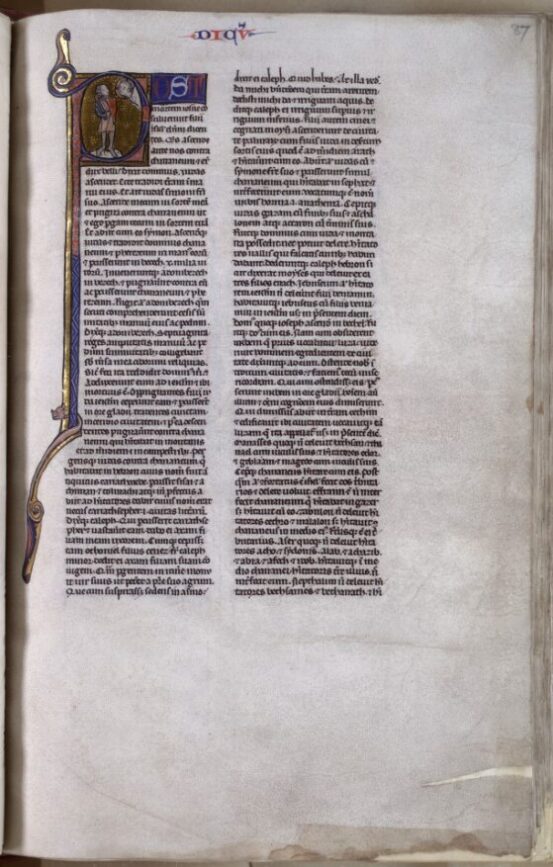
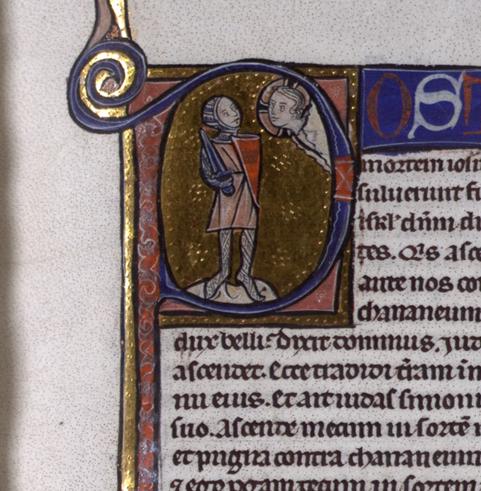
Judah Communicating with God
This image shows Judah dressed in armour and communicating with God. The image is attached to the Book of Judges.
Judah and his family wage many battles in the Book of Judges. They often fight against a group of people called the Canaanites (indigenous people of the ancient Levant). The Book of Judges begins with the conquests and wars waged by Judah after God grants him land. Judah and his forces conquered Jerusalem among other cities. The artist here has depicted the moment God speaks to Judah, while Judah is dressed and ready for war.
Judah’s armour and sword are the type worn and used by people when the manuscript was painted. We can date artwork by the clothes that people wear in images because medieval people often painted figures wearing the fashions of the time.
Judah is wearing chain mail, which you can see from the detailed lines and close-fitting hood (or coif). Over his chainmail, Judah wears a surcoat (a cloth tunic worn over amour) in light red, he holds a red heater shield (a common type of shield for this period) in his left hand and a sword in his right hand. Judah’s sword has two edges, a decorative cross guard and a round pommel. He looks every part like a soldier ready for war.
The sword is unsheathed, showing the blade clearly to the viewer, and it is held ready for action in an upright position. This sword highlights Judah’s role as a warrior or knight prepared for battle. The sword is an important symbol of leadership, military power and authority. Judah is the head of the Tribe of Judah, namesake of the Kingdom of Judah, land of Judea and the word Jew, as well as an ancestor of Jesus.
The sword is also a metaphor in Judges for Judah as a conquering force. Over and over this Book of the Bible refers to how Judah and his family put others to the sword.
Saul’s Suicide
This page shows the suicide of Saul. He falls on his sword and then throws himself into the sea. Saul’s death takes place at the end of the 1st Book of Samuel and the image here marks the beginning of the 2nd Book of Samuel, also called The Second Book of Kings.

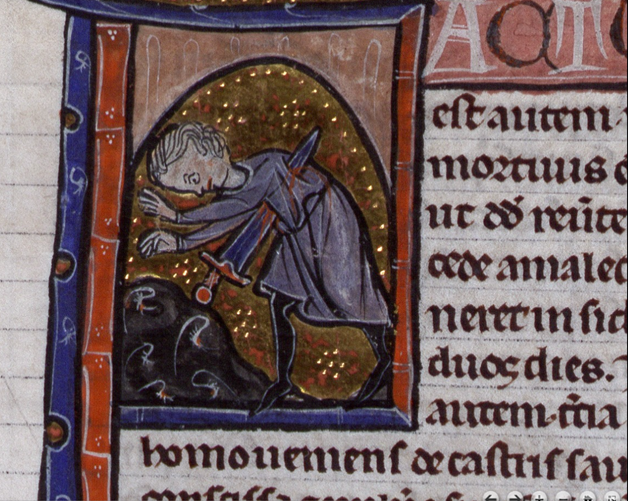
Saul’s Suicide
Saul and his family (men of Israel) lost the battle against the Philistines. Saul sees that all his sons have died in battle and then Saul falls on his sword because he does not want to be killed or taken by the Philistines.
Saul was afraid of the Philistine’s army and afraid of what they might do to him. Saul knew from a prophecy that he and his sons would die, and his land would be conquered because he disobeyed God.
Saul’s actions as king and then suicide are often presented negatively in medieval works. For example, in Dante’s Purgatorio (Purgatory, written in the early 1300s) Saul is presented as representing the sin of pride.
In this image, Saul is painted without armour and in a simple blue tunic. However, this is inconsistent with the text. In the First Book of Samuel, the Philistines strip Saul’s armour from his body after death and so sometimes in other artwork of this period he is drawn still in his armour.
By presenting Saul out of armour and without a crown when committing suicide, the illustrator may have wanted to focus a viewer’s attention away from a valiant death when fighting in battle, to instead reflect on a king and warrior who is lowered.
This image is very different from the image of Judah. Here Saul is alone because God no longer speaks to him. Saul is without his armour-bearer, an attendant who would have given Saul prestige. Saul is also without armour or any marks of his previously high status as he falls into a dark sea. Saul is lowered by his actions and his army’s defeat in battle.
Judith beheading Holofernes
This page shows an illustration of Judith beheading Holofernes. Judith is a Jewish widow who kills the Assyrian General Holofernes, who is besieging her city.
In the Vulgate Bible (the medieval Latin Bible) there is a Book of Judith. This Book is placed in the Apocrypha (texts not part of accepted religious canon) of some Bibles like the King James Bible. It is not present in modern translations of the Bible. Here the illustration has been drawn in the initial marking the beginning of the Book of Job.
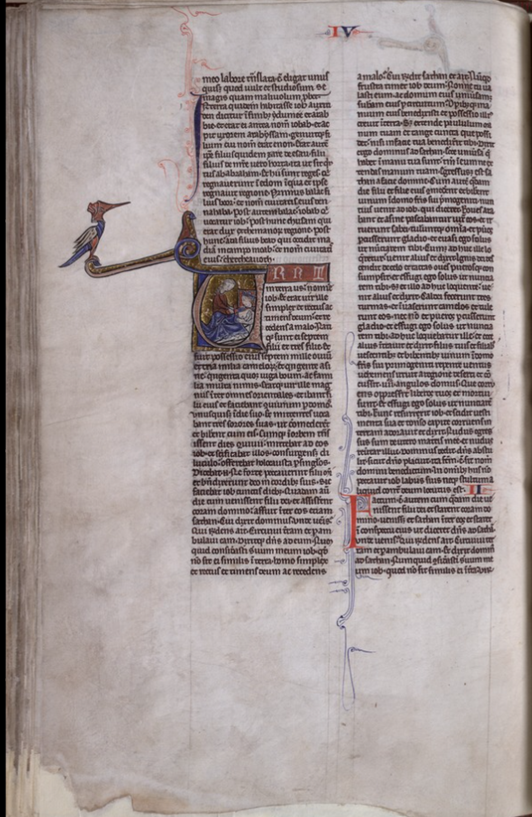
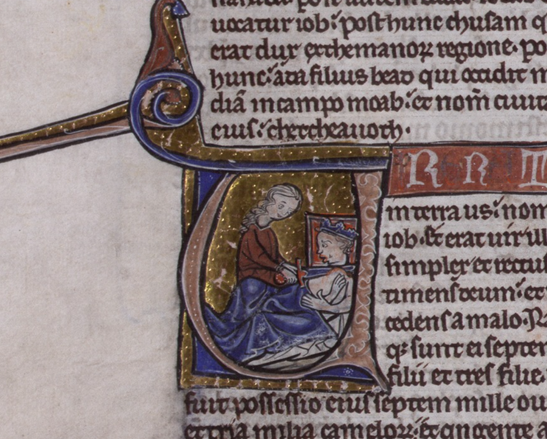
Judith beheading Holofernes
The Book of Judith and the image here act as a reminder that those involved in conflict are not just men who fight in battle. The Book of Judith begins with descriptions of the military might of the Assyrians as they sweep across the land, conquering and destroying everything in their path. In this Book, there is a concern for people, especially women and children, who live in occupied areas and face the horrors of war. The Book stresses the importance of protecting those who are oppressed.
Judith stands against the governor’s orders to give the city to the Assyrians. She dresses beautifully, goes to Holofernes’ tent, and she pretends to offer him a way of capturing the land easily.
Judith gets Holoferens drunk and then beheads him with his own sword. After this, seeing Holofernes’ severed head, the army retreats and Judith’s city is saved. Through her actions, the nearby city of Jerusalem and the land of Israel are also saved.
This image depicts the heroine Judith at its centre. She firmly takes action and is depicted grasping the sword with both hands, suggesting the force and determination in her actions. Judith is painted in a powerful position. She is at the centre of the image, with her posture towering over Holoferens. As his head is crowned, Holoferns’ is a powerful foe, but when Judith defeats him, she severs the invading army’s control over the land. Judith takes Holoferen’s sword, a tool and symbol of his conquest, and uses it against him.
Judith is depicted as beautiful and wise. The painter has given close attention to Judith’s portrait, giving her a high forehead and long flowing hair. Her face appears calm and determined, a stark contrast to Holoferens’ almost comically surprised face.
The image of Judith beheading Holofernes within a decorated initial was popular in Bibles of this period. Judith was considered a moral example, virtuous and heroic when overcoming evil to protect her people. She has been compared to David defeating Goliath. Judith’s actions inspired a vast range of artwork, music and drama from the medieval through to the early modern period. Wars and invasions during the medieval period could sometimes influence popular retellings of Judith’s story.
Nebuchadnezzar besieges Jerusalem
This page shows Nebuchadenezzar besieging Jerusalem. Nebuchadeneazzar II (born BCE 605 and died BCE 562) was king of the Neo-Babylonian Empire. He conquered Judah and besieged Jerusalem. He then destroyed the city and the First Temple. His image is presented before the Book of Daniel.
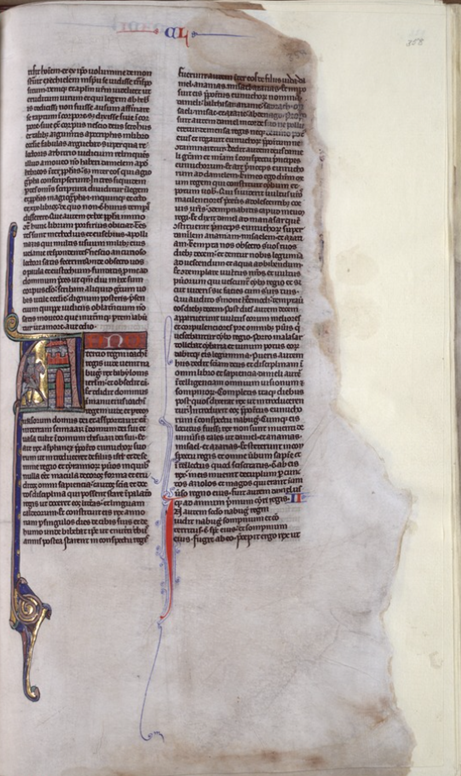
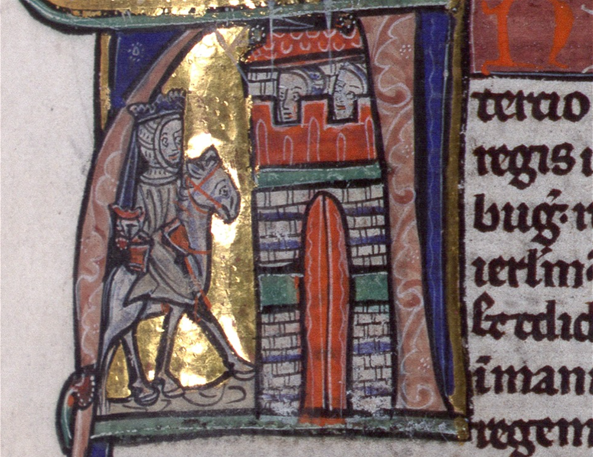
Nebuchadnezzar besieges Jerusalem
Nebuchadenezzar here besieges Jerusalem. He represents the besieging army as he arrives on horseback, wearing armour (here chainmail and a surcoat), with an upright drawn sword and a crown on his head.
This image is beautifully adorned with gold leaf in the background. It depicts a large colourful tower which represents the City of Jerusalem. In the medieval imagination, the city of Jerusalem was both a real city and an imagined ideal city. As a historical and real city, Jerusalem was important as the place of the Crucifixion of Jesus and home to many relics. However, it was also described in the Bible as the Heavenly City where, after the End of Times, true believers would live. So, it is not surprising that this image would be decorated so beautifully and brightly.
This image of Nebuchadenezzar conquering Jerusalem might have resonated with a viewer in the period when this Bible was made. The Bible was produced around 1260, a period characterised by the Crusades. The Crusades were Holy Wars, fought across Europe and the Middle East. Crusades were particularly fought in the Middle East between 1095 and 1291. Jerusalem was conquered by Christian forces in 1099, but then reconquered by Muslim forces in 1187. Later attempts to recapture Jerusalem by Christian forces in the Crusades were only of limited success and often disastrous. In the first half of the 13th century, before the making of this manuscript, there were several crusades targeting the Middle East. These included the Fourth Crusade (1202-4), Fifth Crusade (1217-21), Sixth Crusade (1228-29), The Baron’s Crusade (1239-1241) and Seventh Crusade (1248-54).
Gated towers and city walls are often found in depictions of Jerusalem in medieval art. Gates like these were common features of medieval walled cities. Examples of medieval walls still stand today in cities close to Ripon like York. The city of Jerusalem had walls which were demolished during war (the Crusades) in 1219, so that it would be indefensible. However, the Heavenly Jerusalem’s gates and walls are described in the Bible.
St Paul with a sword (493r)
This image shows a page from the Pauline Epistles (the Letters of Paul), part of the New Testament.
It is decorated with an image of St Paul with the tool of his martyrdom, a sword.
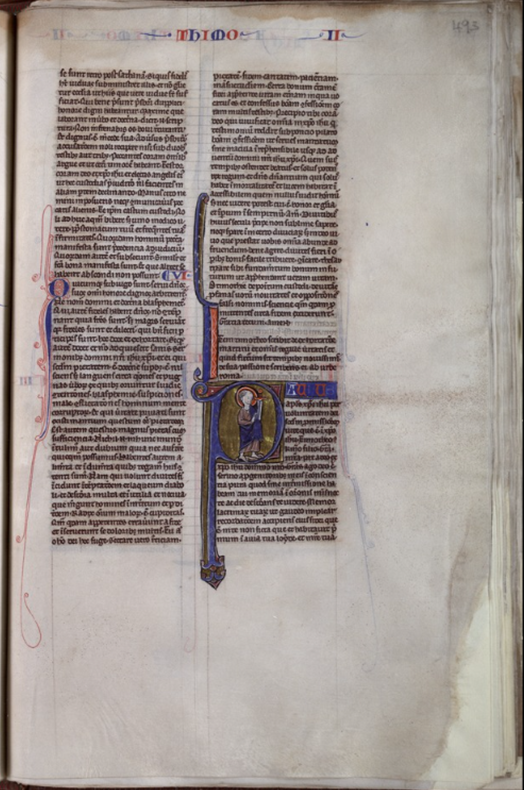
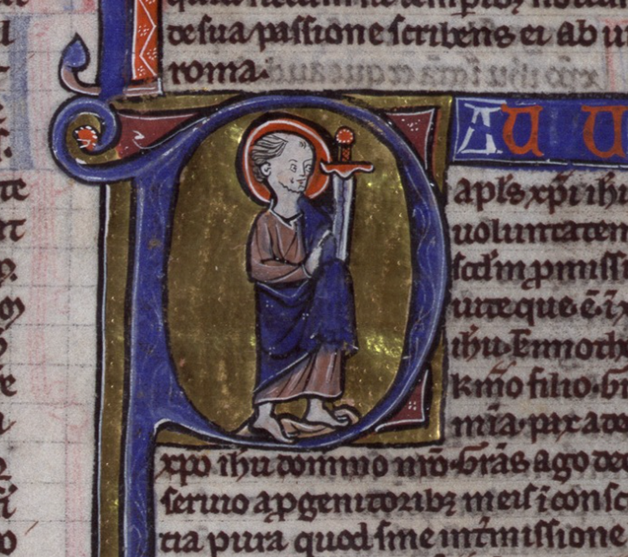
St Paul with a sword (493r)
St Paul was one of the Apostles of Jesus. He is credited as writing part of the New Testament.
St Paul was martyred (persecuted and killed for his faith) when he was beheaded with a sword.
This beautifully illustrated image shows St Paul, with a halo behind his head and a background of gold leaf. The vibrant blue and gold of the initial P draws the eye to this focal point on the page.
St Paul’s epistles contain a famous quote about the armour of God in Ephesians 6:10-18:
Finally, my brethren, be strong in the Lord, and in the power of his might. Put on the whole armour of God, that ye may be able to stand against the wiles of the devil. For we wrestle not against flesh and blood, but against principalities, against powers, against the rulers of the darkness of this world, against spiritual wickedness in high places. Wherefore take unto you the whole armour of God, that ye may be able to withstand in the evil day, and having done all, to stand. Stand therefore, having your loins girt about with truth, and having on the breastplate of righteousness; And your feet shod with the preparation of the gospel of peace; Above all, taking the shield of faith, wherewith ye shall be able to quench all the fiery darts of the wicked. And take the helmet of salvation, and the sword of the Spirit, which is the word of God: Praying always with all prayer and supplication in the Spirit, and watching thereunto with all perseverance and supplication for all saints; (from the King James version of the Bible)
The Armour of God is usually interpreted as a spiritual battle against the Devil or evil. Christians would face such battles by putting on the armour of their faith.
Connections between arms, armour and warfare with the Christian faith have been made in countless Christian literary works. Christian symbolism has been given to items of arms and armour in literature, even Christ himself is represented in some works as a soldier or knight fighting evil.